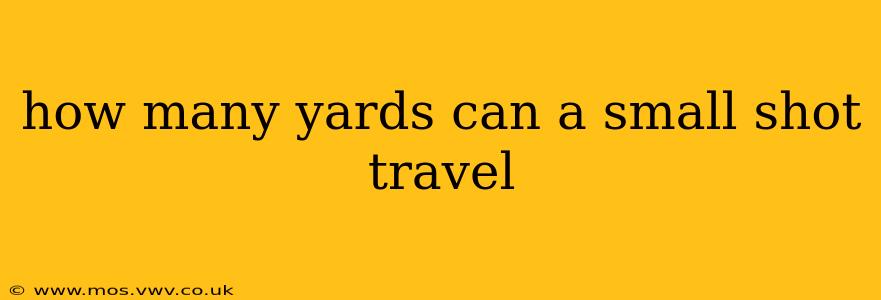The distance a small-gauge shotgun shell travels depends on several crucial factors, making a definitive answer impossible. However, we can explore the variables and provide a reasonable range. Understanding the limitations of this question is key: we're talking about potential range, not effective range for hunting or self-defense.
What Factors Influence Shotgun Range?
Several factors significantly impact how far a small-gauge shotgun shell (like a .410 bore or 28-gauge) can travel:
-
Gauge: Smaller gauges (.410 bore, 28 gauge) generally have less shot weight and less powder than larger gauges (12 gauge, 20 gauge), resulting in shorter range. The smaller the gauge, the less powerful the shot.
-
Shot Type: Different shot types (e.g., birdshot, buckshot, slugs) have drastically different ranges. Birdshot, designed for close-range bird hunting, loses velocity quickly. Buckshot, with larger pellets, travels farther but still less than slugs. Slugs, essentially single projectiles, have the longest range of all.
-
Choke: The choke of the shotgun barrel affects shot pattern and range. A full choke constricts the shot pattern, resulting in tighter grouping and potentially longer range, but at the expense of wider shot spread at shorter distances. A modified choke offers a balance between range and pattern size. An improved cylinder choke has the widest pattern and shortest effective range.
-
Powder Charge: The amount of gunpowder in the shell directly influences the velocity and, consequently, the range of the shot. Higher powder charges mean longer range.
-
Barrel Length: Longer barrels generally impart more velocity to the shot, leading to increased range.
-
Environmental Conditions: Wind, temperature, and humidity can all affect the trajectory and range of a shotgun shell. Headwinds will decrease range, while tailwinds will increase it.
How Far Can Different Shot Types Travel?
This section is crucial to clarify the vast differences in range potential depending on the type of shot used. These distances represent maximum potential ranges in ideal conditions and are not ranges suitable for safe or effective use.
-
Birdshot (.410 or 28 gauge): A maximum range of around 50-75 yards is possible, but the shot will likely be widely dispersed and lose much of its energy far before this. Effective hunting range is much, much shorter.
-
Buckshot (.410 or 28 gauge): Buckshot might travel up to 100-150 yards, but again, effective range is considerably shorter, and accuracy diminishes drastically at longer distances.
-
Slugs (.410 or 28 gauge): Slugs could potentially reach 200 yards or more under ideal conditions, but precise aiming becomes extremely challenging at these ranges.
What is the Effective Range of a Small-Gauge Shotgun?
The effective range is far less than the maximum potential range. Effective range refers to the distance at which the shot pattern remains dense enough to reliably hit a target. For small-gauge shotguns, especially with birdshot, the effective range is generally much less than 40 yards. With buckshot, it might extend to 50 yards, but accuracy will decrease rapidly beyond this. For slugs, the effective range might be 100 yards or slightly more for skilled marksmen, but this depends heavily on the firearm and ammunition.
Is it Safe to Shoot a Small-Gauge Shotgun?
Yes, small-gauge shotguns are safe to shoot when handled responsibly. However, it's crucial to remember that even small-gauge shotguns can cause serious injury or death at ranges much shorter than their maximum potential. Always follow firearm safety rules, including:
- Treat every firearm as if it were loaded.
- Never point a firearm at anything you do not intend to shoot.
- Keep your finger off the trigger until ready to shoot.
- Be sure of your target and what is beyond it.
Remember, this information is for educational purposes only. Always consult with a qualified firearms instructor for proper training and safety procedures before handling any firearm.
